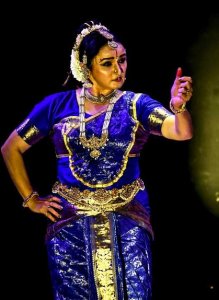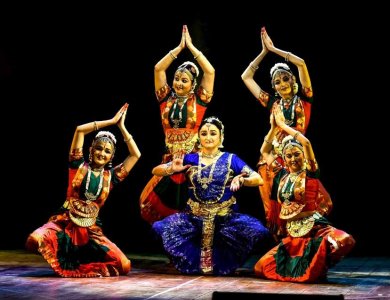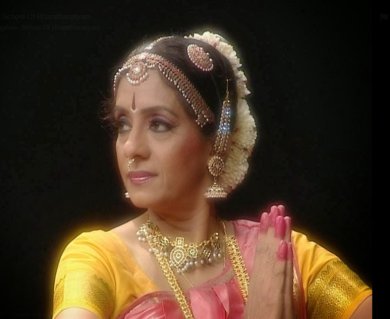
|   |

|   |
 e-mail: sunilkothari1933@gmail.com 5th Margazhi Dance Festival at Navi Mumbai January 12, 2017 It was an eye opener for me to attend the 5th Margazhi Dance Festival that spanned 3 different days at Vashi, New Mumbai, held by G.V. Ramani Foundation's Takshashila Dance Academy and Kalpavruksha Dance Academy. Though I am a Mumbaikar, having moved away from there in 1980 to Kolkata and then to New Delhi, my connections with Mumbai are strong. When I visit Mumbai, it gives me an opportunity to see how in last 30 years classical dance scene has developed. In particular, the development of forms like Bharatanatyam in greater Mumbai has been quite impressive. Besides the pioneers like late Kuppaiah Pillai and his sons Guru Mahalingam, Kalyanasundaram and son-in-law Govindraj Pillai and their Rajarajeswari Bharatanatya Kala Mandir, others like gurus Kalasadan Mani, G. V. Ramani and Rajee Narayan have also contributed to popularise Bharatanatyam . Mumbai has extended to Navi Mumbai with these two principal institutions, running academies for dance and holding annual Margazhi festivals. I attended the opening day proceedings on 18th December at the spacious CIDCO Exhibition Centre auditorium near Vashi railway station. It has an excellent auditorium run by Municipal Corporation providing facilities for cultural events. Takshashila Dance Academy run by Gayatri Subramaniam, disciple of Guru G.V. Ramani is one of Navi Mumbai's oldest classical dance schools, established in 1990. Since its inception it has enrolled around 250 students. Some of the senior students now perform in various dance festivals. Co-founder and director of Kalpavruksh, Kalpana Prakash who joins Gayatri in organizing Margazhi Festival informed me that besides Bharatanatyam, they arrange for performances and workshops by leading dancers in Mumbai, exponents of different dance forms like Manipuri, Odissi, Kathak and Mohiniattam. They organize two events which are now regular features in Navi Mumbai's cultural calendar. The Margazhi fest is held in December and in January. The second festival Utsav showcases young artists to new audiences. After the inauguration, Takshashila Dance Company's disciples presented group Bharatanatyam dance numbers and a video was screened to show the activities of the academy. The principal dancers for the evening were Dr. Sandhya Purecha and her disciples, and Dhananjayans' first student Shobhana Bhalchandra from Chennai.  Sandhya Purecha  Sandhya Purecha and disciples Sandhya presented few items from a set of 18 rare items of Raja Serfoji's 'Korvayanche Sahityache Jinnas.' These compositions are in Marathi. Acharya Parvati Kumar, Sandhya's guru has set them to music and tala and choreographed them. Sandhya has been following Parvati Kumar's legacy. The Thanjavur Nritya Prabandh is set to one raga and one tala. It is in old and simple Marathi. The narration of imaginary story wherein a young, childish, bashful unnamed nayika is imparted worldly knowledge in a friendly manner by an elderly, mature and affectionate harem attendant. Besides Jay Jay, Sharanu, Alaru items, Sandhya presented Swarapada in Suruti raga and rupaka tala. In conversation with sakhi, the nayika tells her, she wonders why her Lord Shiva is called Bholanath. Is it because he consumes poison at the behest of gods? "In fact when he gave me, his own wife to Bhasmasura, I, Parvati too called him Bholanath. Then why must I question others who address him as Bholanath? When he gave me half his body I was overwhelmed with the thought of how much love and affection he had towards me. But is it fair that his second wife Ganga has a seat on his head. How could Bhola cheat thus? Is it because he lost his clothes in gamble and became digambar? Ravana deceitfully asked him for Shivalinga and unhesitatingly he gave it away. No wonder he is addressed as Bholanath." The repertoire is quite interesting with images and metaphors. The Marathi title is 'Sakhina Nayikes Buddhivada Sangaychi Kalpitkatha' meaning the imaginary dialogue with nayika. Sandhya chose Swarajati in Pantuvarali raga and tisra ata tala, in which proudha nayika tells the mugdha nayika when she has to meet her beloved, she should part her hair, wear colourful clothes, embellish her body when he comes to meet her, she should welcome him with a smile, and when he teases her to please her, she must not sulk, and when he speaks to her in solitude fill his heart with sweet murmur, but must not disclose her desires before he wants her to. Sandhya had her two disciples Chitra Dalvi and Suhani Dhanki playing role of mugdha nayikas. Both are young and registered bhavas well portraying bashfulness. The abhinaya pada in ragam Kalyani and adi tala had the title 'Viharinikruta Manmathopalamba Kalpitkatha,' the imaginary narration of nayika admonishing Manmatha who mistook her for Lord Shiva for various reasons. She tells Madana not to torment her mistaking her to be Lord Shiva. She is distraught in separation from her lover. Therefore she is in pain, and not in meditation like Shiva. She has not done her hair and it is dishevelled and not Shiva's jata; she has not applied ash on her body, she is pale because she is in separation. She does not wear crescent moon, but the flower in her hair is withered and dried up, and he must not mistake it as crescent moon on Shiva's head. Do her clothes look like hide of an elephant which Shiva wears? They are withered and must not be taken as hide of elephant which Shiva wears. She begs Madana to step out of the illusion. Similar pada is penned by Vidyapati where nayika tells Madana not to mistake her for Shiva: Kahe dahat Madana, tanu hamar? (Why do you burn my body, O Madana?) Sandhya concluded her presentation with Chitra and Suhani performing Jakkini in Sankarabharanam and adi tala. It is not an item in Bharatanatyam, but seems to be in Kuchipudi. In Kuchipudi because it is in Andhra and there is a tribe Jakkulu, some mistake this number as performed in lieu of tillana. It has interesting terms "Yalila Yalle Yale" which has popular folk element. Both Chitra and Suhani performed it with abandon. Sandhya's performance was of her usual verve and high standard. It had popular appeal as many Mumbaikars follow simple Marathi used in the songs.  Shobanaa Bhalchandra
The festival was divided in three days with interval of few days. On 20th December, Gayatri Subramaniam's conceived and choreographed dance in Bharatanatyam was based upon three women - Ahalya, Draupadi and Seeta: Mortal lives and Immortal women. Manipuri dances included Manipuri Raas by Darshana Jhaveri and pung cholom and martial arts were staged by Thingom Brojen Singh and group from Manipur. I missed watching these shows. On 7th January 2017 Revathi Ramachandran and troupe were to present 'Jagat Pavani Ganga.' Since I was to leave for Chennai, I planned to watch the show in Chennai on 2nd January at Sri Krishna Gana Sabha and review it. Revathi Ramachandran and her institution Kala Sadhanalaya presented her ambitious choreographic work with concept, design and choreography by her and music composition by Lalgudi G.J.R. Krishnan. The music production and arrangements were undertaken by Sai Shravanam. It included special lighting designed by Venkatesh Krishnan; the sutradhar who delivered story in English was Karthik Ananth Subramaniam. The Mime- MacTrics were by Sravanth T.R, Vikas M, Naresh D, Sidharth Varma, Mime music by V.I. Ranjith and costumes by D.S. Aiyellu, Sivakumar. Credit for facilitator is given to Dushyanth Gunashekhar. The collaborative work performed by a group of freelance Bharatanatyam dancers of high standard and Revathi's own daughter Manasvini and other disciples, this multi arts production for one hour and 40 minutes engaged the audience's attention from the word go to the finale highlighting the glorious past of Ganga to present day plight and an appeal to all to stop further polluting her and save it as a great heritage of Bharat. If there is no Ganga, there will be no Bharat was the message conveyed through dance, dialogue, music, mime and visuals. The libretto of the production is interpreted with ancient and contemporary verses which extol the need to preserve Ganga's purity and sanctity. The production combines Bharatanatyam, classical Carnatic music, Gadhwali music and Himachali folk dances, mime and theatre. Praised in Rigveda, rhetorical texts , Sanskrit poems by Kalidasa and Valmiki the production unfolds with group dance, describing the flora and fauna, the beauty of nature giving choreographer ample scope to depict the movement of gurgling waters, the fish, crocodile, the trees on the banks, the animals galloping with lilting music. The story of Shantanu marrying Ganga, her condition not to question her when she was immersing newborn babies, but when Shantanu stopped her immersing the eight child, Ganga left him. The eighth child was Bhishma, Gangeya. The story of ashta vasus, the impertinence of princes in order to captivate the horse and Kapi muni's wrath, the resultant repentance, Bhagirtha's penance, Brahma's advice to worship Shiva, request to Ganga to descend on earth so that one hundred children could receive moksha, Ganga's descent and Shiva's capturing her in his jata were enacted with imaginative choreography. The flowing Ganga turning into one flow standing behind Shiva and received by Shiva was brilliant, so was the lighting. References from history, of Emperor Akbar preferring Ganga water, mentioned by Abul Fazal and its geographical vastness covering Himachal displaying the joys of Himachali people, their songs and folk dances in colourful costumes received applause from audience. Similarly when the Ganga aarati was performed and lamps were placed to float in Ganga water, the clever ploy of moving the blue cloth suggesting and showing lamps floating and moving were excellent visuals. Audience clapped and sang Ganga aarati with the dancers, so powerful was the impact of shared tradition. With all this jubilation the Sutradhar spoke about what people have done to Ganga. He needs to be careful when speaking about Alaka nagari and Halahala poison. Both were mispronounced. A series of mime and shadow play showing destruction of trees, land and helplessness of wild elephants, with versatile mime art were depicted. And when the image of Shiva with crescent moon on jata was shown, the audience applauded for the artistry and illusion involved. Not to despair, the production moved on culminating in a philosophical introspection of the ecological value systems that is gripping the society. The final tillana performed with joy by the entire cast gave the hope that eternal Ganga would never be destroyed. The production was indeed challenging. It is to the credit of Revathi to muster all courage and resources, support and teamwork with use of imaginative technology to essay the glory of the great river in a seamless manner. However, the opening verses and detailed description of flora and fauna, animals etc could have been edited to make the presentation more compact, as the narration becomes too long. Since the music is recorded and the choreography set, perhaps it is now too late to make any changes.  Dr. Sunil Kothari is a dance historian, scholar, author and critic. He is honored with Padma Shri, Sangeet Natak Akademi award and Senior Critic Award from Dance Critics Association, NYC. Post your comments Please provide your name and email id when you use the Anonymous profile in the blog to post a comment. All appropriate comments posted with name & email id in the blog will also be featured in the site. |